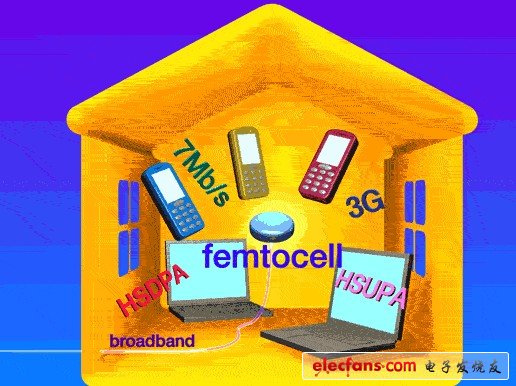Global operators will implement the first deployment of Small-Cell access technology this year to achieve the purpose of high-density coverage of 3G and 4G network capacity. Wireless operators have a soft spot for small base station technology. The main purpose is to increase bandwidth in places where users frequently use mobile phones, including shopping malls, stadiums, public squares, city parks, and busy commercial areas.

The new trend of small base stations may be just the beginning. The installation areas of the first base stations are mainly concentrated on outdoor lampposts and ceilings. The European Commission has mobilized the resources of several technology companies and universities to form a joint committee. It is conducting research on the concept of "ultra-dense network", which can implement a large number of micro base stations in each room. Of course, we are not limited to talking about small-scale networks, but to the level of popularizing all mankind.
The committee has a slightly funny name: "Mobile and wireless communicaTIons Enablers for the Twenty-twenty InformaTIon Society", but the short name for this name is MeTIs, which is relatively cool. MeTIs has received 16 million euros (21.2 million US dollars) from the European Union. Its main job is to deeply identify network technologies beyond the LTE-Advanced standard being developed.
Jan Färjh, head of the standardization and industry (ERIC) department of Ericsson as a pioneer network supplier of Metis, said that these so-called 5G technologies may appear in many forms. It can be a new wireless interface or a new cellular architecture , Such as heterogeneous networks and wide area mobile networks, may even appear in the form of virtualization of the network itself. Färjh uses the word "possible" because no one in the committee can determine what form of network will appear in 2020 and beyond. These new technologies are at the forefront of the times, and Metis' goal is to determine which of them are technically and commercially feasible.
"We must prepare for the LTE and LTE-Advanced technologies in the world 10 years later," Färjh said. Although network providers and standard setting agencies have put forward some ideas on the evolution of our network in 2020, Färjh said, the specific form of these networks is not clear enough.
To this end, Metis is conducting investigations in various fields and conducting in-depth research projects in the laboratory of academic institutions such as Aalborg University in Denmark and Poznan University of Technology in Poland. Although some major manufacturers and operators, including Alcatel-Lucent (ALU), Nokia (NOK), and Telefónica (TEF), are members of the committee, Metis is contrary to traditional wireless industry guidelines and absorbs BMW. Wait for the company to join. Färjh said that one of the areas that Metis will focus on development will be "Internet of Vehicles"-one day, cars will be network access points, rather than pure end nodes.
Färjh said another area Metis will delve into is exploring the possibility of baseband processing moving to the cloud. Today's radio access network (RAN) is designed so that each base station processor can handle the peak load of its cell, but only a small part of the area reaches peak capacity during the day. Therefore, a large part of the processing power is idle in the entire network. Some vendors, such as Intel (INTC), have proposed to transfer these base stations to the cloud to establish a set of shared processing resources.
"If we have a flexible architecture, and you can distribute processing power to any network in need, what will happen?" Färjh said, "We can take a virtualization model and apply it to mobile networks. "
Färjh said that in addition to the "vehicle-to-vehicle" connection, Metis will also study device nodes in dedicated networks. In the past, we communicated directly through the tower, but now our phones and gadgets can also transfer data between each other in a giant network, and finally through the most effective connection or connection combination, the data is offloaded to the mobile network.
Färjh said that it is difficult to predict whether all technologies will pass Metis ’s final review after 30 months, or if only some technologies will pass the review. These technologies may be feasible in themselves, but the actual operation is another matter. For example, backhaul is a practical obstacle encountered in ultra-dense networks and cloud-RAN, because both of them need to be inserted into huge transportation pipelines. We are not only planning the future of "networks", but also the "network" technologies used to support these networks.
The electrolyte material inside the Electrolytic capacitor, which has charge storage, is divided into positive and negative polarity, similar to the battery, and cannot be connected backwards.A metal substrate having an oxide film attached to a positive electrode and a negative electrode connected to an electrolyte (solid and non-solid) through a metal plate.
Nonpolar (dual polarity) Electrolytic Capacitor adopts double oxide film structure, similar to the two polar electrolytic capacitor after two connected to the cathode, the two electrodes of two metal plates respectively (both with oxide film), two groups of oxide film as the electrolyte in the middle.Polar electrolytic capacitors usually play the role of power filter, decoupling (like u), signal coupling, time constant setting and dc isolation in power circuit, medium frequency and low frequency circuit.Non-polar electrolytic capacitors are usually used in audio frequency divider circuit, television S correction circuit and starting circuit of single-phase motor.
Electrolytic capacitor
Electrolytic Capacitor,Aluminum Electrolytic Capacitor,High Voltage Electrolytic Capacitor,12V Electronic Components Capacitor
YANGZHOU POSITIONING TECH CO., LTD , https://www.yzpstcc.com
